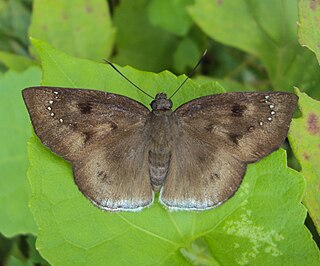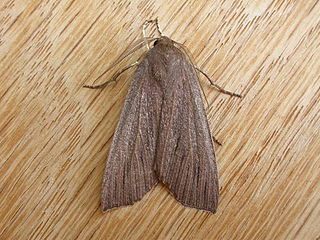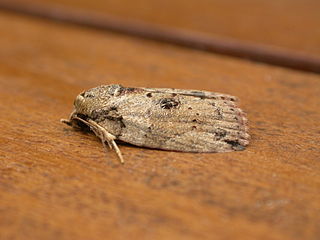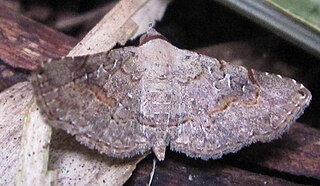
Tagiades gana, the immaculate snow flat, large snow flat or suffused snow flat, is a butterfly belonging to the family Hesperiidae found in Indomalayan realm.

Arsacia is a monotypic moth genus of the family Noctuidae. Its only species is Arsacia rectalis. Both the genus and species were described by Francis Walker, the genus in 1866 and the species in 1863. It is found from the Indo-Australian tropics of India, Sri Lanka to Queensland and the Solomon Islands.

Palleopa is a monotypic moth genus in the family Geometridae. Its only species, Palleopa innotata, the finely-streaked crest-moth, is known from Australia, including Tasmania. Both the genus and species were first described by Francis Walker in 1866.

Nanaguna breviuscula, the pigeonpea pod borer, is a moth species of the family Nolidae. It is found from Sri Lanka and India east to Samoa. In Australia it is found in the Kimberleys in Western Australia, the northern part of the Northern Territory and from the Torres Strait Islands and Queensland to Sydney in New South Wales.

Crocydopora is a monotypic snout moth genus described by Edward Meyrick in 1882. Its single species, Crocydopora cinigerella, described by Francis Walker in 1866 is known from Australia and New Zealand.
Curena is a genus of snout moths. It was described by Francis Walker in 1866.
Curena caustopa is a species of snout moth in the genus Curena described by Alfred Jefferis Turner in 1905. It is found in Queensland, Australia.
Hypsopygia decoloralis is a species of snout moth in the genus Hypsopygia. It was described by Julius Lederer in 1863 and is found in Australia.

Hypena conscitalis is a moth of the family Erebidae first described by Francis Walker in 1866. It is found throughout Africa, from Senegal to South Africa, in South and South-East Asia as well as in Australia and on some Pacific and Indian Ocean islands.

Rhesala moestalis is a species of moth of the family Noctuidae first described by Francis Walker in 1866. It is found throughout subtropical Africa, from Sierra Leone in the west to Somalia in the east and South Africa in the south. It is also found on most of the African Indian Ocean islands. and in South and South-East Asia.

Banisia myrsusalis, the sapodilla borer or sapota midrib folder, is a species of moth of the family Thyrididae. It was described by Francis Walker in 1859 and is found in North America, Brazil, Australia, southern Asia and Africa.
Lambula pristina is a moth of the family Erebidae. It was described by Francis Walker in 1866. It is found in Australia.

Agrioglypta eurytusalis is a moth in the family Crambidae described by Francis Walker in 1859. It is found in southern India, Sri Lanka, Borneo, Cambodia, Thailand, Taiwan, Japan and Australia, where it has been recorded from northern Queensland.
Agrioglypta excelsalis is a moth in the family Crambidae described by Francis Walker in 1866. It is found on Sulawesi, Lifou Island, as well as in Bhutan, Thailand and Australia, where it has been Western Australia, Queensland and northern New South Wales.

Cotachena histricalis is a moth in the family Crambidae. It was described by Francis Walker in 1859.It is found in New Guinea, Indonesia and on the Solomon Islands, as well as in China and Australia, where it has been recorded from Queensland.
Cydalima diaphanalis is a moth in the family Crambidae. It was described by Francis Walker in 1866. It is found in Burma, Indonesia, on the Solomon Islands and in Thailand and Australia, where it has been recorded from Queensland and South Australia.
Omiodes surrectalis is a moth in the family Crambidae. Described by Francis Walker in 1866, it is found in the Democratic Republic of the Congo, India, Indonesia, the Philippines, Sri Lanka, New Guinea and Queensland, Australia.

Hyposidra talaca, the black looper or black inch worm, is a moth of the family Geometridae. The species was first described by Francis Walker in 1860. It is found from India to Indochina, Sundaland, Sulawesi, the Philippines, Sri Lanka, the Solomon Islands, Thailand, Taiwan, New Guinea and Australia, where it has been recorded from Queensland. It is a major defoliating pest in tea plantations.
Epiplema quadristrigata is a moth of the family Uraniidae first described by Francis Walker in 1866. It is found in Australia and Sri Lanka.
Giaura tortricoides is a moth of the family Nolidae first described by Francis Walker in 1865. It is found in Sri Lanka, Japan, Andaman Islands, Borneo, Sumatra, Flores, Sulawesi, New Guinea, Bismarck Islands and Australia.










